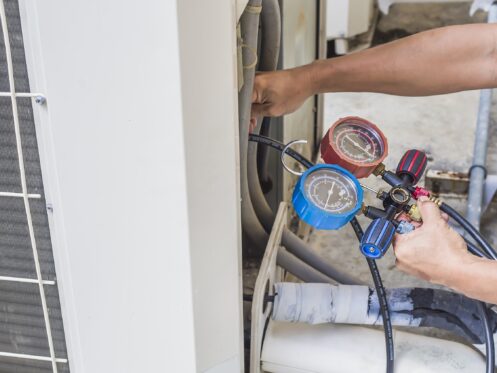Modern HVAC systems have revolutionized our thoughts on heating and cooling when creating the perfect indoor environment. In this age of advanced technology, two terms have been making waves in the HVAC industry: VRV and VRF systems. It would be best to understand the differences between these systems to decide on your HVAC needs.
Understanding VRV and VRF Systems
Variable refrigerant volume (VRV) and variable refrigerant flow (VRF) systems stand as groundbreaking advancements in air conditioning technology, aiming to strike a delicate balance between precise temperature regulation and energy efficiency. These systems introduce a paradigm shift by enabling zoned comfort control, which empowers users to set distinct temperature preferences for separate sections or rooms within a structure. This innovative approach proves especially advantageous in expansive environments, where diverse heating and cooling needs emerge across the spatial landscape.
History of VRV and VRF Systems
In the early 1980s, a pivotal era in HVAC evolution, the seeds of variable refrigerant volume (VRV) and variable refrigerant flow (VRF) systems were sown, tracing their origins to the innovative landscape of Japan. These transformative technologies emerged in response to the glaring inadequacies of conventional HVAC solutions, particularly in achieving personalized comfort within sprawling commercial establishments.
Daikin Industries, an industry visionary, spearheaded this technological revolution and introduced the VRV concept as a breakthrough solution. Over time, the VRV framework matured into the comprehensive and versatile variable refrigerant flow systems that revolutionize temperature control and energy efficiency across diverse domains today.
How VRV and VRF Systems Work
VRV and VRF systems harness the fundamental principle of heat transfer via refrigerant circulation. However, their differences become apparent in how they execute this process. Specifically, VRV systems specialize in dynamically adjusting the refrigerant volume to precisely match the diverse needs of distinct zones within a building.
In contrast, VRF systems encompass a broader array of technologies, spanning multiple manufacturers, which collectively regulate refrigerant flow to achieve comparable goals of customized climate control. This distinction highlights the proprietary nature of VRV while emphasizing the inclusivity of VRF, catering to a wider range of applications.
Differences Between VRV and VRF Systems
The distinction between VRV and VRF systems lies in their proprietary nature and the scope of their inclusivity. VRV, a term coined by Daikin, represents a specific subset within the broader spectrum of VRF systems. Every VRV system is inherently a VRF system due to its shared foundation of refrigerant-based heat transfer.
However, it’s essential to recognize that not all VRF systems can be labeled as VRV systems. Understanding this differentiation fosters a clearer grasp of the HVAC industry’s innovative trajectory and the diverse offerings to cater to various heating and cooling demands.
Advantages of VRV and VRF Systems
The merits of VRV systems lie in their precision-based zoning capability, which facilitates personalized temperature regulation across multiple zones concurrently. This attribute proves especially advantageous in spaces with diverse thermal needs. Furthermore, VRV systems excel in energy efficiency by adeptly adjusting refrigerant volume in response to demand, culminating in minimized energy usage and noticeable cost-effectiveness.
VRF systems encompass these energy-efficient attributes, including VRV and akin technologies. The shared advantage of catering to distinct zones with varying temperature requirements remains a defining feature. Both VRV and VRF systems provide efficient and adaptable climate control solutions for a wide spectrum of environments.
Disadvantages of VRV and VRF Systems
These systems require specialized installation and maintenance due to their intricacies. VRV systems might demand proprietary expertise, potentially limiting servicing options. However, VRF systems, being a broader category, provide more flexibility regarding maintenance and repair professionals.
Applications of VRV and VRF Systems
These systems hold the unique capability to establish discrete climate zones, all while upholding impressive energy efficiency standards. This adaptability renders them particularly fitting for spaces characterized by shifting occupancy patterns or disparate heating and cooling prerequisites. From bustling offices to serene hospital rooms and cozy residences, VRV and VRF systems provide a unified solution that aligns comfort and sustainability.
Types of VRV and VRF Systems
In VRF systems, there exist distinctive variations to address varied needs. Heat pump systems emerge as a solution with dual functionality, providing heating and cooling functionalities. Conversely, the concept of heat recovery systems takes center stage, allowing for simultaneous heating and cooling within separate zones.
Such diversity in VRF offerings reflects the HVAC industry’s commitment to catering to a spectrum of needs, ultimately enhancing the precision and efficiency of climate control solutions.
Installation of VRV and VRF Systems
Achieving peak performance necessitates accurate sizing, strategic positioning, and meticulous configuration of both indoor and outdoor units. Notably, the distinction in installation between VRV and VRF systems revolves around their complexities.
VRV systems, with their proprietary design, might demand an extra layer of expertise unique to their manufacturer. In contrast, VRF systems offer a broader spectrum of installation approaches due to their encompassing nature. Engaging professionals with the requisite knowledge and experience is recommended to execute a seamless installation, ensuring that each system’s intricacies are well-handled for optimal functionality and efficiency.
Maintenance of VRV and VRF Systems
Regular upkeep encompasses cleaning or replacing filters, monitoring refrigerant levels, scrutinizing electrical connections, and guaranteeing unobstructed airflow. VRV systems, with their proprietary design, might demand specialized attention in servicing, requiring technicians with distinct expertise. On the other hand, VRF systems generally offer a wider pool of professionals equipped to handle maintenance tasks.
Scheduling routine maintenance elongates the system’s operational lifespan and serves as a preventive measure, curbing the potential escalation of minor issues into more substantial and costly repairs.
Environmental Footprint of VRV and VRF Systems
The proprietary nature of VRV systems may result in more controlled and streamlined manufacturing processes, potentially minimizing resource usage and waste. On the other hand, VRF systems might offer a variety of manufacturers, leading to variations in production practices. As these systems evolve, innovations in materials, refrigerants, and manufacturing methods will likely further enhance their environmental friendliness, making VRV and VRF systems pivotal contributors to greener HVAC solutions.
The Future of VRV and VRF Systems
VRV systems might see continued refinement in their intricacies, promoting efficiency and precision. Meanwhile, VRF systems, with their inclusive nature, could benefit from a wider spectrum of innovations, paving the way for user-friendly interfaces and enhanced energy management.
Embracing VRV and VRF Technologies
Modern HVAC technology’s distinctions between VRV and VRF systems are pivotal in shaping our indoor environments. At A/C & Plumbing Doctors, we’re committed to providing comprehensive insights and services that empower your HVAC decisions.
Beyond the VRV and VRF systems world, A/C & Plumbing Doctors offers a comprehensive suite of HVAC services designed to enhance your comfort. From traditional systems to cutting-edge technologies, we excel in installation, maintenance, and repairs, ensuring your HVAC system remains efficient and reliable. As the HVAC industry evolves, so do we, ensuring that you have access to the latest advancements and sustainable solutions. Contact A/C & Plumbing Doctors in Gilbert, AZ for expert advice, dependable services, and a more comfortable tomorrow!





